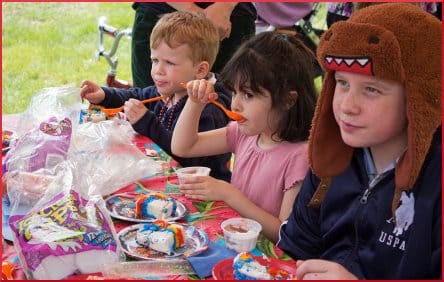
Childhood Obesity News has mentioned the EarlyBird Study many times, and has used the term “childhood obesity epidemic” many times. They are found together in an interesting article that says:
There may not be just one childhood obesity epidemic, but two (or more). The widely-held belief that the entire childhood population is at risk of obesity may not be correct.
Good grief! Wasn’t one childhood obesity epidemic enough? But it’s a theory, and it’s easy to see what they’re suggesting — two different demographic bulges, so to speak:
The trends imply that, before puberty, only a subgroup of the population is at risk. With puberty, the skew in fatness that characterizes early childhood gives way to widening of its variance, suggesting a new wave of obesity which this time involves most of the population. The changing pattern suggests that different factors at different ages are responsible for today’s childhood obesity, some operating early in life, and others much later.
A factor that would be more likely to kick in later is food addiction, because it does take some time to effloresce into a major problem. But the seeds of it sprout early, so the more tender stages of childhood should be surrounded by prevention awareness.
In the two childhood obesity epidemics, another very different factor is the impact of peers. Basically, the whole culture is based on the same time-honored impulse to form in-groups and punish the out-groups. But the need to imitate others can be expressed differently at different stages of development, or lack thereof. Cliques of 5-year-olds have different rules and different enforcement procedures than cliques of 15-year-olds. Which is one of the reasons why:
More than one solution may be needed to prevent obesity in childhood.
Childhood Obesity News also looked at the work done by Dr. Jennifer Li and her group regarding social networks, both online and in real life. They confirmed that, as the old saying goes, “birds of a feather flock together.” Often, when an expression like “peer group pressure” is used, the underlying attitude seems to be that influence is only a bad thing.
A study or two, and a ton of empirical experience, have shown that harmful influences are more successful than beneficial ones in swaying the behavior of others. When Dr. Li’s team does research, however, they start with the assumption that people can influence each other in positive ways. It is that tendency on which they hope to concentrate.
Dr. Goutham Rao wrote:
Overweight children, for example, are more likely to have peers with the same characteristics and behaviors, either through selection of similar peers or adoption of specific habits of those in their network.
That is another way of saying that nobody is sure whether overweight kids hang out together because of that commonality; or whether the habits that lead to overweight tend to “rub off” on kids who would not have otherwise become obese. Or both.
Either way, the power of social networking can be harnessed and channeled into beneficial purposes. Using social networks to influence health in positive ways is what many health professionals see as the “next logical step,” and it was in this context that Dr. Li cited Dr. Pretlow’s Weigh2Rock website as a good example.
The American Heart Association, which commissioned Dr. Li’s study, now hopes that online communities of children and young people who are overweight or obese will constitute a “ripple effect” with ever-widening influence.
Your responses and feedback are welcome!
Source: “Key Findings from EarlyBird,” EarlyBirdDiabetes.org
Source: “The Promise of Social Networks and Social Media in Tackling Childhood Obesity,” MyAmericanHeart.org, 12/03/12
Source: “Social Media Could Help Curb Childhood Obesity, Heart Association Says,” iHealthBeat, 12/06/12
Image by Melissa Majorowski.

 FAQs and Media Requests:
FAQs and Media Requests: 











